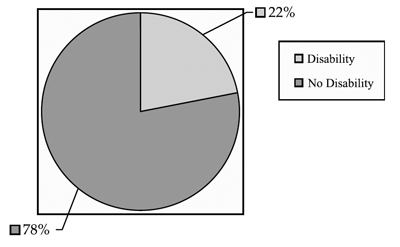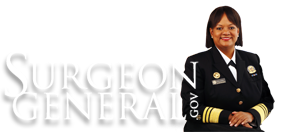The Surgeon General’s Call to Action to Improve the Health and Wellness of Persons with Disabilities
Introduction
Today, approximately 54 million individuals of all ages, races, ethnicities, socioeconomic status and educational attainment in the United States live with at least one disability (McNeil 2001; 1997) (See Figure 1). Disabilities have been defined in many ways. In general, however, disabilities are characteristics of the body, mind, or senses that, to a greater or lesser extent, affect a person’s ability to engage in some or all aspects of day-to-day life. Some disabilities are visible; others are not. Some are physical, some visual or auditory, some developmental or cognitive, and some mental or behavioral. Some persons are born with one or more disabilities; others acquire a disability during the course of a lifetime. Most individuals in the United States will experience a disability of some duration at some point in their lives.
Different kinds of disabilities affect people in different ways. No single disabling condition necessarily affects one person in exactly the same way as it does another. Yet, persons with disabilities of all kinds share many of the same challenges when it comes to their own health and well-being.
Disability is not an illness. The concept of health means the same for persons with or without disabilities: achieving and sustaining an optimal level of wellness—both physical and mental—that promotes a fullness of life (Krahn 2003). For persons with disabilities, as for those without disabilities, to be healthy, it means having the tools and knowledge to help promote wellness and knowing the risk factors that can promote illness and the protective factors that can prevent it. For persons with all kinds of disabilities it also means knowing that conditions secondary to a disability—from pain to depression and from urinary tract infections to heightened susceptibility to acute illnesses—can be treated successfully. Health also means that persons with disabilities can access appropriate, integrated, culturally sensitive and respectful health care that meets the needs of a whole person, not just a disability.
When it comes to focusing attention on meeting those health care challenges for persons with disabilities, Clancy and Andresen (2002) assert that “healthcare delivery has been slower to come to the fore than other areas.” Thus, while much has been accomplished through such efforts as the Americans with Disabilities Act (1990), the President’s New Freedom Initiative, his HealthierUS initiative, and the U.S. Department of Health and Human Services’ Healthy People, much more remains to be done. Challenges to the health and wellness of persons with disabilities continue, as does the need to meet those challenges and overcome them.
Figure 1: Percentage of Americans With Disabilities (based on McNeil 2001)

Some of the challenges arise from insufficient knowledge and awareness; some arise from provider and community attitudes and behaviors. Some challenges are the result of inadequate access to information and opportunities for appropriate health care and wellness promotion. Still others are the product of service systems that do not always make use of innovative and creative approaches to enhancing the health and wellness of persons with disabilities.
This Call to Action responds to those challenges. It is based on a simple principle: good health is necessary for persons with disabilities to secure the freedom to work, learn and engage in their families and communities. The Call to Action further delineates four specific goals:
GOAL 1: People nationwide understand that persons with disabilities can lead long, healthy, productive lives.
GOAL 2: Health care providers have the knowledge and tools to screen, diagnose and treat the whole person with a disability with dignity.
GOAL 3: Persons with disabilities can promote their own good health by developing and maintaining healthy lifestyles.
GOAL 4: Accessible health care and support services promote independence for persons with disabilities.
This Call to Action helps identify barriers to overcome and suggests direction to improve the health and wellness of persons with disabilities and to promote their engagement in school, in work, in worship, in family and in the overall fabric of life in ways unimagined a century ago. It sets forth a vision for the future and challenges America to action. The work to achieve the vision of this Call to Action, however, must take place at the federal, state, tribal and community levels in policy and programs; in infrastructure and education; and in the hearts, minds and actions of persons with disabilities and their families, health care providers—including paraprofessionals and professionals—in the health care system, and a concerned, informed public.
A Personal Story—Access Ignored I was so frustrated at having to tell the people in the emergency room “I can't get up on the gurney; I can't stand up to do this; you're going to have to get someone to help me get on this examination table” … and they just look at you like, “Hey, what's the problem?” |
The Call to Action was developed by the Surgeon General in collaboration with the Department’s Office on Disability. In order to ensure input from the disability community, a focus group was held in October of 2004 in which nine individuals of varying disabilities were invited to participate. The focus group received a presentation on the report from the Office on Disability. Overall, participants had a favorable reaction to the draft and their additional comments and suggestions were incorporated into the final version of the Call to Action.
Last revised: January 4, 2007






